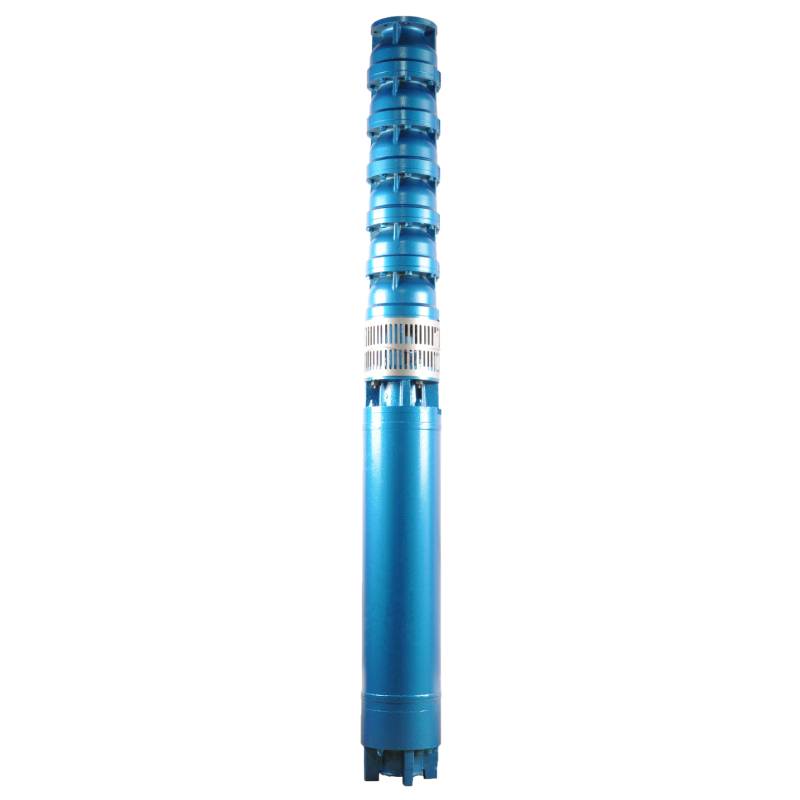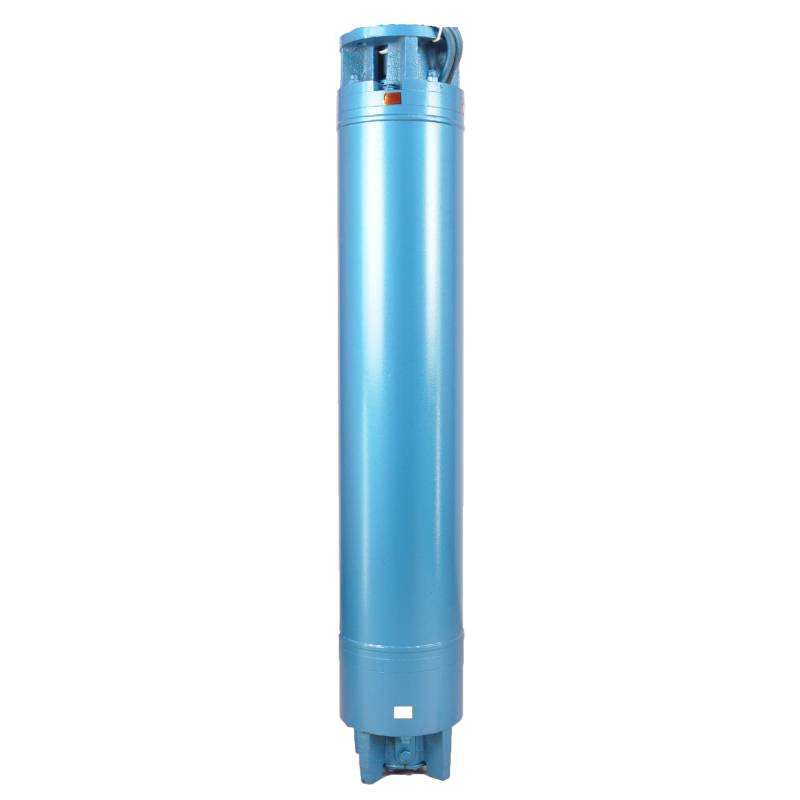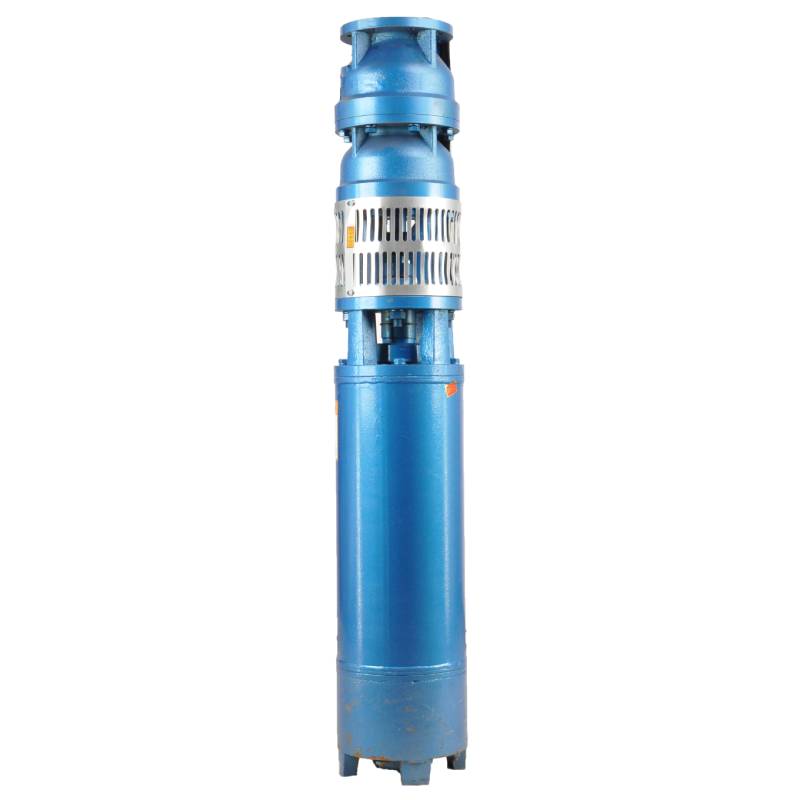The product adopts special waterproof wire design, which can realize long-term stable conversion operation of the motor within the frequency range of 1HZ-50HZ. The frequency conversion winding design not only makes the frequency conversion deep well pump more energy saving, but also prolongs its service life. The motor winding adopts special water-resistant conductors that are resistant to high frequency impact, pulse peak voltage impact and high temperature aging, with excellent characteristics and stability.
The product is powered by three-phase AC 380V power supply, 50HZ frequency, suitable for the environment with harsh water quality conditions. Specific requirements include water temperature below 20 °C, solid impurities content is not greater than 0.01%, PH value is 6.5-8.5, hydrogen sulfide content is not greater than 1.5mg/L, chloride ion content is not greater than 400mg/L. The product adopts closed or water immersion structure of the motor, before use to ensure that the pump is fully filled with water, no-load test run is strictly prohibited. The pump must be completely immersed in water, not more than 70m water depth, water source to meet the requirements of the pump water output and continuous operation. In addition, the well must be vertical, the pump can only be used vertically. The wiring should be supported according to the requirements, and equipped with external overload protection device. This series of requirements to ensure the efficient and stable operation of the product, suitable for all kinds of special environment of the pump demand.
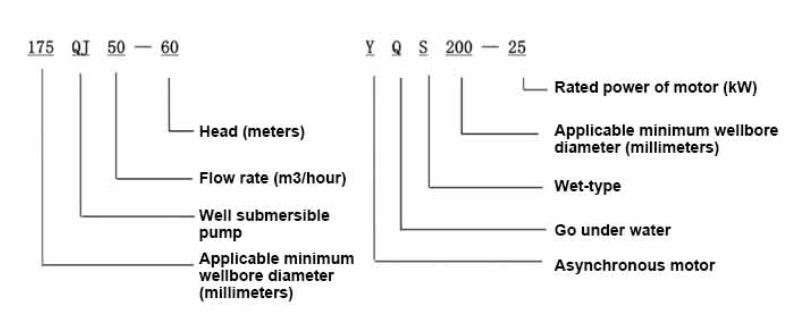
| Tauira | Rere (m3/h) | Upoko (m) |
Tere hurihuri (hurihia/tohu) |
Puma wai(%) | Putanga diameter (mm) |
E tika ana diameter(mm) |
Whakatauria power(KW) |
Whakatauria ngaohiko(V) |
Whakatauria nāianei(A) |
Te Motika (%) | power factorcosφ | Waeine Rahi Morahi Radial(mm) |
Korero | |||||||||
| 250QJ50-40 | 50 | 40 | 2875 | 72 | 80 | 250runga | 9.2 | 380 | 21.7 | 78.5 | 0.82 | 233 | ||||||||||
| 250QJ50-60 | 60 | 13 | 30.1 | 80.0 | 0.82 | |||||||||||||||||
| 250QJ50-80 | 80 | 18.5 | 40.8 | 82.0 | 0.84 | |||||||||||||||||
| 250QJ50-100 | 100 | 22 | 47.9 | 83.0 | 0.84 | |||||||||||||||||
| 250QJ50-120 | 120 | 25 | 53.8 | 84.0 | 0.84 | |||||||||||||||||
| 250QJ50-140 | 140 | 30 | 64.2 | 84.5 | 0.84 | |||||||||||||||||
| 250QJ50-160 | 160 | 37 | 77.8 | 85.0 | 0.85 | |||||||||||||||||
| 250QJ50-200 | 200 | 45 | 94.1 | 85.5 | 0.85 | |||||||||||||||||
| 250QJ50-240 | 240 | 55 | 114.3 | 86.0 | 0.85 | |||||||||||||||||
| 250QJ50-280 | 280 | 63 | 131.0 | 86.0 | 0.85 | |||||||||||||||||
| 250QJ50-320 | 320 | 75 | 152.3 | 87.0 | 0.86 | |||||||||||||||||
| 250QJ50-400 | 400 | 90 | 182.8 | 87.0 | 0.86 | |||||||||||||||||
| 250QJ50-440 | 440 | 100 | 203.1 | 87.0 | 0.86 | |||||||||||||||||
| 250QJ63-40 | 63 | 40 | 2875 | 74 | 80 | 250runga | 11 | 380 | 25.8 | 79.0 | 0.82 | 233 | ||||||||||
| 250QJ63-60 | 60 | 18.5 | 40.8 | 82.0 | 0.84 | |||||||||||||||||
| 250QJ63-80 | 80 | 22 | 47.9 | 83.0 | 0.84 | |||||||||||||||||
| 250QJ63-100 | 100 | 30 | 64.2 | 84.5 | 0.84 | |||||||||||||||||
| 250QJ63-120 | 120 | 37 | 77.8 | 85.0 | 0.85 | |||||||||||||||||
| 250QJ63-160 | 160 | 45 | 94.1 | 85.5 | 0.85 | |||||||||||||||||
| 250QJ63-200 | 200 | 55 | 114.3 | 86.0 | 0.85 | |||||||||||||||||
| 250QJ63-220 | 220 | 63 | 131.0 | 86.0 | 0.85 | |||||||||||||||||
| 250QJ63-260 | 260 | 75 | 152.3 | 87.0 | 0.86 | |||||||||||||||||
| 250QJ63-300 | 300 | 90 | 182.8 | 87.0 | 0.86 | |||||||||||||||||
| 250QJ63-360 | 360 | 100 | 203.1 | 87.0 | 0.86 | |||||||||||||||||
| 250QJ80-20 | 80 | 20 | 2875 | 75 | 100 | 250runga | 7.5 | 380 | 18.0 | 78.0 | 0.81 | 233 | ||||||||||
| 250QJ80-40 | 40 | 15 | 33.9 | 81.0 | 0.83 | |||||||||||||||||
| 250QJ80-60 | 60 | 22 | 47.9 | 83.0 | 0.84 | |||||||||||||||||
| 250QJ80-80 | 80 | 30 | 64.2 | 84.5 | 0.84 | |||||||||||||||||
| 250QJ80-100 | 100 | 37 | 77.8 | 85.0 | 0.85 | |||||||||||||||||
| 250QJ80-120 | 120 | 45 | 94.1 | 85.5 | 0.85 | |||||||||||||||||
| 250QJ80-160 | 80 | 160 | 2875 | 75 | 100 | 250runga | 55 | 380 | 114.3 | 86.0 | 0.85 | 233 | ||||||||||
| 250QJ80-180 | 180 | 63 | 131.0 | 86.0 | 0.85 | |||||||||||||||||
| 250QJ80-200 | 200 | 75 | 152.3 | 87.0 | 0.86 | |||||||||||||||||
| 250QJ80-240 | 240 | 90 | 182.8 | 87.0 | 0.86 | |||||||||||||||||
| 250QJ80-280 | 280 | 100 | 203.1 | 87.0 | 0.86 | |||||||||||||||||
| 250QJ100-18 | 100 | 18 | 2875 | 75 | 100 | 250runga | 7.5 | 380 | 18.0 | 78.0 | 0.81 | 233 | ||||||||||
| 250QJ100-36 | 36 | 15 | 33.9 | 81.0 | 0.83 | |||||||||||||||||
| 250QJ100-54 | 54 | 25 | 53.8 | 84.0 | 0.84 | |||||||||||||||||
| 250QJ100-72 | 72 | 30 | 64.2 | 84.5 | 0.84 | |||||||||||||||||
| 250QJ100-90 | 90 | 37 | 77.8 | 85.0 | 0.85 | |||||||||||||||||
| 250QJ100-108 | 108 | 45 | 94.1 | 85.5 | 0.85 | |||||||||||||||||
| 250QJ100-126 | 126 | 55 | 114.3 | 86.0 | 0.85 | |||||||||||||||||
| 250QJ100-144 | 144 | 63 | 131.0 | 86.0 | 0.85 | |||||||||||||||||
| 250QJ100-162 | 162 | 75 | 152.3 | 87.0 | 0.86 | |||||||||||||||||
| 250QJ100-198 | 198 | 90 | 182.8 | 87.0 | 0.86 | |||||||||||||||||
| 250QJ100-216 | 216 | 100 | 203.1 | 87.0 | 0.86 | |||||||||||||||||
| 250QJ125-16 | 125 | 16 | 2875 | 76 | 125 | 250runga | 9.2 | 380 | 21.7 | 78.5 | 0.82 | 233 | ||||||||||
| 250QJ125-32 | 32 | 18.5 | 40.8 | 82.0 | 0.84 | |||||||||||||||||
| 250QJ125-48 | 48 | 25 | 53.8 | 84.0 | 0.84 | |||||||||||||||||
| 250QJ125-64 | 64 | 37 | 77.8 | 85.0 | 0.85 | |||||||||||||||||
| 250QJ125-80 | 80 | 45 | 94.1 | 85.5 | 0.85 | |||||||||||||||||
| 250QJ125-96 | 96 | 55 | 114.3 | 86.0 | 0.85 | |||||||||||||||||
| 250QJ125-112 | 112 | 63 | 131.0 | 86.0 | 0.85 | |||||||||||||||||
| 250QJ125-128 | 128 | 75 | 152.3 | 87.0 | 0.86 | |||||||||||||||||
| 250QJ125-160 | 160 | 90 | 182.8 | 87.0 | 0.86 | |||||||||||||||||
| 250QJ125-176 | 176 | 100 | 203.1 | 87.0 | 0.86 | |||||||||||||||||
| 250QJ125-192 | 192 | 110 | 219.6 | 87.5 | 0.87 | |||||||||||||||||
| 250QJ140-15 | 140 | 15 | 2875 | 76 | 125 | 250runga | 9.2 | 380 | 21.7 | 78.5 | 0.82 | 233 | ||||||||||
| 250QJ140-30 | 30 | 18.5 | 40.8 | 82.0 | 0.84 | |||||||||||||||||
| 250QJ140-45 | 45 | 30 | 64.2 | 84.5 | 0.84 | |||||||||||||||||
| 250QJ140-60 | 60 | 37 | 77.8 | 85.0 | 0.85 | |||||||||||||||||
| 250QJ140-75 | 45 | 45 | 94.1 | 85.5 | 0.85 | |||||||||||||||||
| 250QJ140-90 | 90 | 55 | 114.3 | 86.0 | 0.85 | |||||||||||||||||
| 250QJ140-105 | 140 | 105 | 2875 | 76 | 125 | 250runga | 63 | 380 | 131.0 | 86.0 | 0.85 | 233 | ||||||||||
| 250QJ140-120 | 120 | 75 | 152.3 | 87.0 | 0.86 | |||||||||||||||||
| 250QJ140-150 | 150 | 90 | 182.8 | 87.0 | 0.86 | |||||||||||||||||
| 250QJ140-165 | 165 | 100 | 203.1 | 87.0 | 0.86 | |||||||||||||||||
| 250QJ140-180 | 180 | 110 | 219.6 | 87.5 | 0.87 | |||||||||||||||||
| 250QJ200-20 | 200 | 20 | 2875 | 75 | 150 | 250runga | 18.5 | 380 | 40.8 | 82.0 | 0.84 | 233 | ||||||||||
| 250QJ200-40 | 40 | 37 | 77.8 | 85.0 | 0.85 | |||||||||||||||||
| 250QJ200-60 | 60 | 55 | 114.3 | 86.0 | 0.85 | |||||||||||||||||
| 250QJ200-80 | 80 | 75 | 152.3 | 87.0 | 0.86 | |||||||||||||||||
| 250QJ200-100 | 100 | 90 | 182.8 | 87.0 | 0.86 | |||||||||||||||||
| 250QJ200-120 | 120 | 100 | 203.1 | 87.0 | 0.86 | |||||||||||||||||
| 250QJ200-140 | 140 | 125 | 249.5 | 87.5 | 0.87 | |||||||||||||||||
1, well submersible pump for clean water pump, prohibit the new well, pumping sediment and muddy water,
2, well water pump voltage grade of 380/50HZ, the use of other voltage grades of submersible motors need to be customized. The underground cable must use waterproof cable, must be equipped with starting equipment, such as distribution box, start not ready should have commonly used motor comprehensive protection function, such as short circuit overload protection, phase protection, undervoltage protection, grounding protection, idling protection, in case of abnormal conditions, the protection device should be timely action trip.
3, the installation and use of the pump must be reliably grounded, prohibit the push and pull switch when the hands and feet are wet, the installation and maintenance of the pump must be cut off the power supply, the use of the pump place to set up "to prevent electric shock" obvious signs:
4, down the well or before installation, the motor cavity must be filled with distilled water or non-corrosive clean cold boiling water, tighten the / water bolt, the pump on the ground test run, must be to the pump chamber water lubrication rubber bearings, instant start not more than a second, see whether the steering is the same as the steering instructions. When the pump is upright, pay attention to safety, prevent overturning injury.
5, kia rite tonu ki nga tikanga o te ara o te papu, te awhe rere o te whakamahi, ki te aukati i te iti o te rere, te teitei ranei o te kaha o te kumara, te peera me etahi atu waahanga o te kakahu, ka wera te motuka motuka.
6, after the pump down the well, the measurement of the motor to the ground insulation resistance should not be less than 100M, after the start to observe the voltage and current, check the motor winding insulation, whether in line with the requirements; pump storage location temperature if less than freezing point, should be dry the motor cavity water, prevent the motor cavity water ice damage caused by low temperature.
The pump parts are mainly composed of pump shaft, impeller, shunt shell, rubber bearing, check valve body and so on; the motor part mainly includes base, pressure regulating diaphragm, thrust bearing, thrust plate, lower guide bearing seat, stator, rotor, upper guide bearing seat, sand discharging ring, water inlet section, cable lead, etc. The main characteristic of the product is that the motor is a water-filled wet submersible three-phase asynchronous motor, the motor cavity is filled with water, used to cool the motor and lubricate the bearing; the pressure regulating diaphragm at the bottom is used to adjust the expansion and contraction pressure difference of the internal water caused by the change of the temperature rise of the motor. In order to prevent the sand particles in the well water from entering the motor, two sand sealing rings are installed on the upper end of the motor shaft extension, and a sand discharging ring is installed to form a sand prevention structure. To prevent the pump shaft from jumping when starting up, the pump shaft is connected with the motor shaft through a coupling, and the thrust bearing is installed on the lower part of the motor. The motor and pump bearing adopt water lubrication technology, and the stator winding of the motor adopts high quality submersible motor winding with high insulation performance. The pump is designed by computer CAD, with simple structure and excellent technical performance.

(1) Whakaritenga i mua i te whakaurunga:
1. Tirohia mehemea ka tutuki te papu ruku ki nga tikanga whakamahi me te whanuitanga kua tohua ki te pukapuka.
2. Ma te whakamahi i te obiect taumaha me te diameter e rite ana ki te teitei o te diameter o waho o te papu ruku, ine mehemea ka uru te inneldiameter o te poka wai ki te papu ruku, me te ine mena ka tutuki te hohonutanga o te puna ki nga whakaritenga whakaurunga.
3. Tirohia mehemea he ma te rua o te puna me te wai pokarekare ranei. Kaua rawa e whakamahia he papu hiko ruku ki te horoi i te paru welor papu me te wai kirikiri kia kore e pakaru wawe te papu hiko ruku.
4. Tirohia mehemea he pai te tuunga o te rawhi whakaurunga welhead me te kaha ki te tu ki te kounga o te waahanga katoa.
5. Tirohia mehemea kua oti te whakaurunga o nga waahanga papu ruku me te tika kia rite ki te hoahoa huinga i roto i te pukapuka Tangohia te mata tātari ka huri i te hononga kia kite mena ka huri ngawari.
6. Wewetehia te wiri wai ka whakakiia te kohao motopaika ki te wai ma, kaua e pirau (tohu. me whakakiia ki runga), katahi ka whakakaha i te kopa wai. I muri i nga haora 12 o te werohia o te wai, kaua e iti iho i te 150M Q te parenga whakamarumaru o te motini ka ine ki te tepu wiri 500V.
7. Cable joint, cut off a 120mm rubber sleeve from one end of the outgoing cable and the matching cable with an electrician's knifethen stagger the length of the three core wires in a stepped shape, peel off a 20mm copper core, scrape of the oxide layer on theoutside of the copper wire with a knife or sand cloth, and insert the two connected wire ends in palirs.After tying the layer tightly with fine copper wire, solder it thoroughly and firmly, and sand of any. burrs on the surface. Then, forthe three joints, use polyvester insulation tape to wrap them in a semi stacked manner for three lavers. Wrap the two ends of thewrapping layer tightywith nyion thread,and then use a semi stacked method to wrap the tape for three layers. Wrap the outellayer with high-pressure insulation tape for three layers. Finally, fold the threestrands together and repeatedly wrap them for fivelayers with high-pressure tape. Each layer must be tightly tied, and the interlayer joints must be tight and fimm to prevent water frompenetrating and damaging the insulation, After wrapping, soak in water at room temperature of 20 ’c for 12 hours, and measurethe insulation resistance with a shaking table, which should not be less than 100M Ω
Ko te hoahoa tukanga waea waea kua honoa e whai ake nei: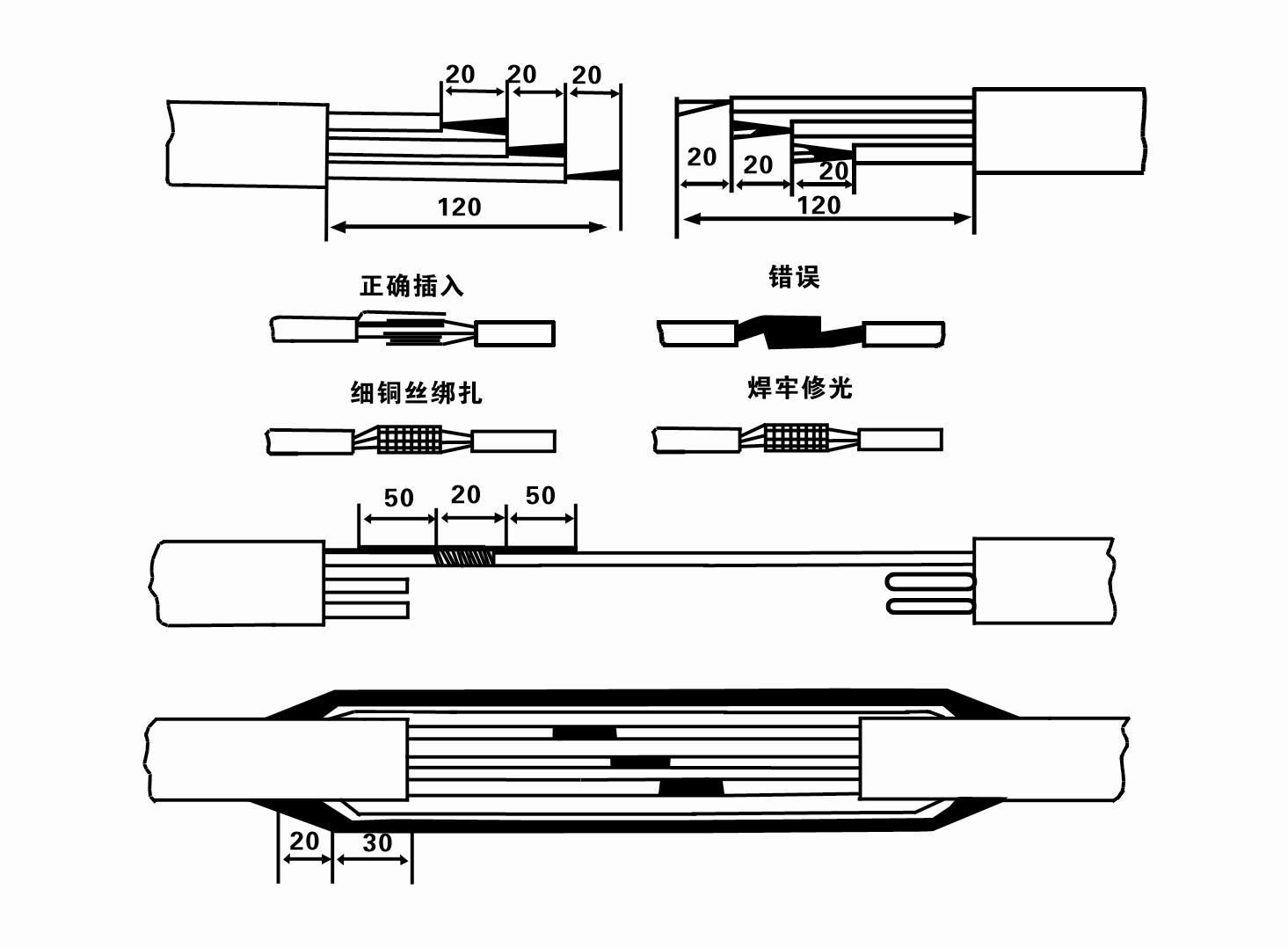
8. Whakamahi i te mita maha ki te tirotiro mena kei te hono nga waea-waa-toru me te ahua taurite te parenga DC.
9. Tirohia mehemea kua taumaha te ara iahiko me te kaha o te hurihanga, katahi ka hono atu i te pana whakamaru i te taumaha, i nga taputapu tiimata ranei. Tirohia te Ripanga 2 mo nga tauira motuhake, katahi ka ringihia he peere wai ki roto i te papu wai mai i te putanga papu wai hei whakahinuhinu i nga rapa rapa i roto i te papu, katahi ka tuu te papu hiko ruku ki runga kia mau. ka tirohia mehemea e rite ana te ahunga urungi ki te tohu urungi. Ki te kore, whakawhitia nga hononga e rua o te taura e toru-waahanga. Katahi ka whakauruhia te tātari ka takatu ki te heke ki raro i te puna. Mena ka whakamahia i roto i nga waahi motuhake (penei i nga awaawa, i nga awaawa, i nga awa, i nga harotoroto, i nga harotoroto, me etahi atu), me tika te turanga o te papu hiko.
(2) Nga taputapu me nga taputapu whakauru:
1. Kotahi te rua o nga mekameka hiki mo te neke atu i te rua tana.
2. He tripod me te teitei poutū kaua e iti iho i te wha mita.
3. E rua nga taura iri (wire ropes) ka taea te kawe i te taumaha neke atu i te kotahi tana (ka taea te kawe i te taumaha o te huinga katoa o nga papu wai).
4. Tāutahia kia rua ngā rawhi (splints).
5. Nga wrenches, hama, wiriwiri, taputapu hiko me nga taputapu, aha atu.
(3)Tautanga papu hiko:
1. Ko te hoahoa whakaurunga o te papu hiko ruku e whakaatuhia ana i te Whakaaturanga 2. Ko nga rahinga whakaurunga motuhake e whakaatuhia ana i te Ripanga 3 "Rarangi o nga Rarangi Whakamutunga o te Pump Hiko Rakau".
2. Ko nga papu hiko ruku me te upoko iti iho i te 30 mita ka taea te whakairi tika ki roto i te puna ma te whakamahi i nga ngongo me nga taura waea, etahi atu taura hemp ranei ka taea te kawe i te taumaha katoa o te miihini, nga paipa wai, me te wai i roto i nga paipa.
3. Ko nga papu me te upoko neke atu i te 30 mita te whakamahi paipa maitai, a ko te raupapa whakaurunga e whai ake nei:
①Whakamahia he rawhi hei rawhi i te pito o runga o te wahanga papu wai (kua honoa te motini me te papu wai i tenei wa), hikitia me te mekameka iri, ka ata herea ki roto i te puna tae noa ki te kuhua te rawhi ki te upoko o te puna ka tango mekameka iri.
② Whakamahia etahi atu rawhi hei rawhi i te paipa, hikitia me te mekameka iri kia 15 cm te tawhiti atu i te flange, ka ata whakaheke. I waenganui i te flange paipa me te flange papu Whakanohoia te papa rapa ki te waahi ka whakakoia te paipa me te papu kia rite ki nga tutaki, nati me nga horoi puna.
③ Whakaarahia te papu ruuma kia paku, tangohia te rawhi i te pito o runga o te papu wai, herea te taura ki te paipa wai me te riipene kirihou, ka ata herea ki raro kia tuu te rawhi ki te upoko puna.
④Whakamahia taua tikanga ki te here i nga paipa wai katoa ki roto i te puna.
⑤I muri i te hono o te taura arataki ki te pana whakahaere, ka hono atu ki te hiko hiko e toru nga wahanga.
(4) Nga mea hei tohu i te wa o te whakaurunga:
1. Mēnā ka kitea he āhuatanga tāmii i te wā e mahi ana te kumara, huri, kumea ranei te paipa wai kia pai ai te taunga. Ki te kore tonu e mahi nga momo mahi, tena koaKaua e tohe te papu ki raro kia kore ai e pakaru te papu hiko ruku me te puna.
2. I te wa o te whakaurunga, me whakanoho he papa rapa ki te taha o ia paipa me te whakakaha kia rite.
3. Ka tukuna te papu wai ki roto i te puna, me tuu ki waenganui o te paipa puna kia kore ai e rere te papu ki te pakitara o te puna mo te wa roa, ka wiri te papu, ka tahia, ka wera te motini. .
4. Whakatauhia te hohonutanga o te papu wai ki raro o te puna i runga i te rere o te onepu me te parapara o te puna. Kaua e tanu te papu ki te paru. Ko te tawhiti mai i te papu wai ki raro o te puna ko te tikanga kaua e iti iho i te 3 mita (tirohia te Whakaahua 2).
5. Ko te hohonutanga o te urunga wai o te papu wai kia kaua e iti iho i te 1-1.5 mita mai i te taumata wai hihiri ki te kohanga uru wai (tirohia te Whakaahua 2). Ki te kore, ka ngawari te pakaru o nga papa papu wai.
6. Ko te hiki o te papu wai e kore e iti rawa. Ki te kore, me whakauru he paera kuaha ki runga i te paipa wai o te upoko o te puna ki te whakahaere i te rere o te papu ki te waahi rere reiti kia kore ai te motini e nui te utaina me te wera na te nui o te rere.
7. I te wa e rere ana te papu wai, me noho tonu te whakaputanga wai me te ara, kia mau tonu te naianei (i raro i nga tikanga mahi kua whakatauhia, ko te tikanga kaua e neke atu i te 10% o te waa kua tohua), kaore he wiri, he haruru ranei. Mena he mate kino, me whakamutu te miihini kia kitea te take me te whakakore.
8. I te wa e whakauru ana, whakarongo ki te whakatakotoranga o te waea motika motika (tirohia te Whakaahua 2). Ina he paipa rino te paipa wai, arahina mai i te rawhi o te upoko puna; ina he paipa kirihou te paipa wai, arahina mai i te tohu whenua o te papu hiko.
- 1.After the submersible pump is installed, check the insulation resistance and three-phase conduction from the switch again, check whether the instrument and the connection of the start 2.equipment are wrong, if there is no problem, the trial machine can be started, and observe whether the indicator readings of the instrument exceed the rated voltage and current specified on 3.the nameplate after the start, and observe whether the pump has noise and vibration phenomenon, and put into operation if everything is normal.
- 4.After the first operation of the pump for four hours, the motor should be shut down to test the thermal insulation resistance quickly, and its value should not be less than 0.5 megaohm.
- 5.After the pump is shut down, it should be started after five minutes to prevent the water column in the pipe from being completely reflowed and causing excessive motor current and burnout.
- 6.After the pump is put into normal operation, in order to prolong its service life, it is necessary to check whether the supply voltage, working current and insulation resistance are normal regularly. If the following conditions are found, the pump should be shut down immediately to troubleshoot.
- 1 In the rated condition, the current exceeds 20%.
- 2 Ka heke te taumata o te wai hihiri ki te wahanga uru wai, ka puta he wai mokowhiti.
- 3 He nui te wiri, te haruru ranei o te papu ruku.
- 4 He iti ake te ngaohiko tuku i te 340 volts.
- 5 Kua wera te ngongo.
- 6 Kua pakaru te paipa tuku wai.
- 7 The motor's thermal insulation resistance is lower than 0.5 megaohm.
- Unit disassembly:
- 1 Untie the cable tie, remove the pipeline part, and remove the wire plate. 2 screw down the water bolt, put the water in the motor chamber.
- 3 tango i te tātari, wetewete te tīwiri pūmau i runga i te hononga ki te whakatika i te rakau nekeneke.
- 4 whakawetohia te raka e hono ana i te waahanga uru wai me te motini, ka wehea te papu mai i te motini (kia tupato ki te urunga o te waeine ina wehe, kia kore ai e piko te pou papu)
- 5 ko te raupapa wetewete o te papu: (tirohia te ahua 1) te waahanga uru wai, te impeller, te anga whakahuri, te impeller...... tirohia te tinana takirere, ka tango i te impeller, whakamahia nga taputapu motuhake hei wewete i te ringaringa koeko o te kua mau. impeller tuatahi, a ka karo i te piko me te maru i te rakau papu i roto i te tukanga o te wetewete.
- 6 ko te mahi wetewete o te motini: (tirohia te ahua 1) tuu te motini ki runga i te papa, ka tango i nga nati, te turanga, te nati maukati mahunga, te pereti pana, te ki, te nohoanga kaiarahi o raro me te raka upoko rua mai i te raro o ka huri te motuka, katahi ka tango i te rotor (kia tupato kia kaua e pakaru te kete waea) ka mutu te tango i te waahanga hono me te nohoanga kaiarahi o runga.
- Huihuinga 7: i mua i te huihuinga, me horoi te waikura me te paru o nga waahanga, ka whakakikoruatia te mata o te mating me nga here ki te hiri, katahi ka whakaemihia i runga i te ritenga o te wetewete (ka neke ake te neke o te motuka motuka i muri i te huihuinga mo te kotahi mirimita), i muri i te huihuinga, me ngawari te hononga, katahi ka te miihini whakamatautau mata tātari. Me tango nga papu ruku i roto i te puna mo te wetewete me te tiaki i runga i te rarangi 5 i muri i te kotahi tau o te mahi, iti iho ranei i te kotahi tau e mahi ana engari e rua tau te wa ruku, ka whakakapia nga wahi kua ruku.
In order to ensure the long-term use and stable performance of submersible electric pump, we have launched a convenient and practical product. The product has a unique design, easy operation, and is perfect for various application scenarios. After use, remember to discharge all the water in the electric pump, especially in winter, so as not to freeze the motor. Wind the cable and bundle it. Store it in an environment without corrosive substances and gases, and keep the temperature below 40 °C. In addition, if you do not use it for a long time, you should pay attention to prevent the submersible electric pump from rusting. Choose our products to make your work more convenient and efficient.
- Kaipupuri
- Karekau kakau
- Karekau rakau rapa
-
mowhiti hiri
01 Te urunga wai hohonu
02 Te tuku wai teitei
03 wai maunga
04 wai pourewa
05 Te whakamakuku ahuwhenua
06 te whakamakuku maara
07 te urunga wai o te awa
08 wai whare

